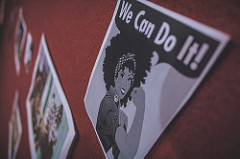The second in a series of blogs on Riot Grrrl, our interviewee Megan Sormus (a Ph.D. researcher at Northumbria University) talked to Girl Museum about alternative girl identities, considered and expressed through the Riot Grrrl scene. Check out our previous blog, Alternative Girl: Introducing Riot Grrrls for more of the interview and for information on Megan and her research!
How have riot grrrls used the current boundaries of cultural expectations of femininity to create new ways of thinking about what it means to be a girl?
“While any notable boundaries that work to restrict alternative formations of femininity or force young women to conform to images, ideals, and meanings deemed to be correct are detrimental, they need to be in place to act as a marker to reflect alternative ways of visualising and enacting girlhood. What I have found most fascinating about riot grrrl throughout my own research is that as a community of young girls, they did not completely conform to the boundaries set by cultural expectations, but they did not completely deride them either. Rather, riot grrrls manipulated these images (as I have suggested in the way they utilised the productive space of the zine) to form new ways of visualising femininities – for example, a key visual for riot grrrl was combining girly, ultra feminine dresses with imposing, statement making boots, such as Dr. Martens – therefore blending masculine and feminine elements all on one surface. Rather than merely existing behind the scenes, the grrrls of riot grrrl made themselves as publicly visible as possible by fronting bands, and dominated the usually male dominated space of the mosh pit at gigs (a keynote for riot grrrl bands was always to encourage ‘girls to the front’). This aesthetic and behavioural contrast confronted cultural expectations by combining conventional ways of behaving with the unconventional. This clever device then opens up all options available to young women through contradiction, allowing the identity of young women to transform into something more fluid.”
How can the Riot Grrrl’s aims for aggression, assertion and bodily freedom be expressed in a positive way?
“I feel that in encouraging girls to be aggressive, assertive, and to have bodily ‘freedom’ could be problematized in that it seems as if they are encouraged to act in deliberately provocative or unsafe ways that may be detrimental to their experience and self. Yet, the reason I feel the aims of aggression/assertion/ bodily freedom are expressed positively within riot grrrl is because of their emphasis on community. Riot grrrl was a collective: a subcultural space that encouraged girls to explore these alternative behaviours in groups. I feel the emphasis placed on girl groups revealed a show of solidarity when pushing such behaviour to the forefront, which made them stronger, more positive, and ultimately safer than individual attempts to behave in a way that might be criticised as being purely antagonistic or offensive.”
What role does music play in the creation of alternative girl identities?
“Alongside the zine, I believe riot grrrl music was the most resounding and significant way of creating alternative girl identities. More than the way in which the zine creates a visual conflict that played with established notions of girlhood, music strengthens this by the combination of language (through lyrics) and sound as a noisy means to self-define. Through this, music allows for the creation of alternative girl identities by its ability to build a rich language of resistance against mass culture. More than this, the space created at live gigs, that promoted an ethos of girls taking centre stage and encouraging girls to the front, encouraged young women to break the boundaries of conventional behaviours. This was at the same time as actively encouraging a girl community, as these spaces are often small and intimate. Ultimately, this reinforced alternative girl identity as a collective, rather than, as convention would have it, merely singular or ostracized.”
Why are alternative ways of viewing and expressing girlhood identity important?
“Throughout my research, I have engaged with multiple studies that refer to the ‘girl’ as a fluid figure with the ability to move between certain categories, especially concerning masculine and feminine (for example, the contrast to switch between being a ‘girly’ girl or a tomboy). While this is not necessarily a new concept, I have found a particular importance placed on the fact that, at such a transitional stage, it is integral for a girl to express and utilise their own possibilities, rather than be restricted to one look or defined code of behaviour. Instead, young women should make use of the power and freedom to move between each – be it through what they wear, read, or listen to- all of these outlets should be fully explored in order to develop girlhood identity, rather than limit it.”
This sneak preview of our upcoming Alternative Girl exhibition, coming to Girl Museum in Spring 2017, is just the beginning of a project rammed full of inspiration girls and women, excellent music and creative female fans, with contributions from women who have dedicated their lives to creating or studying alterative music. If you feel inspired to contribute to this project and have your own musical girlhood tales to tell, take a look at our next blog post in this series. In the meantime, have a think about what music has meant to your girlhood experience. Where would you be without it?
-Sarah Raine
Junior Girl
Girl Museum Inc.


